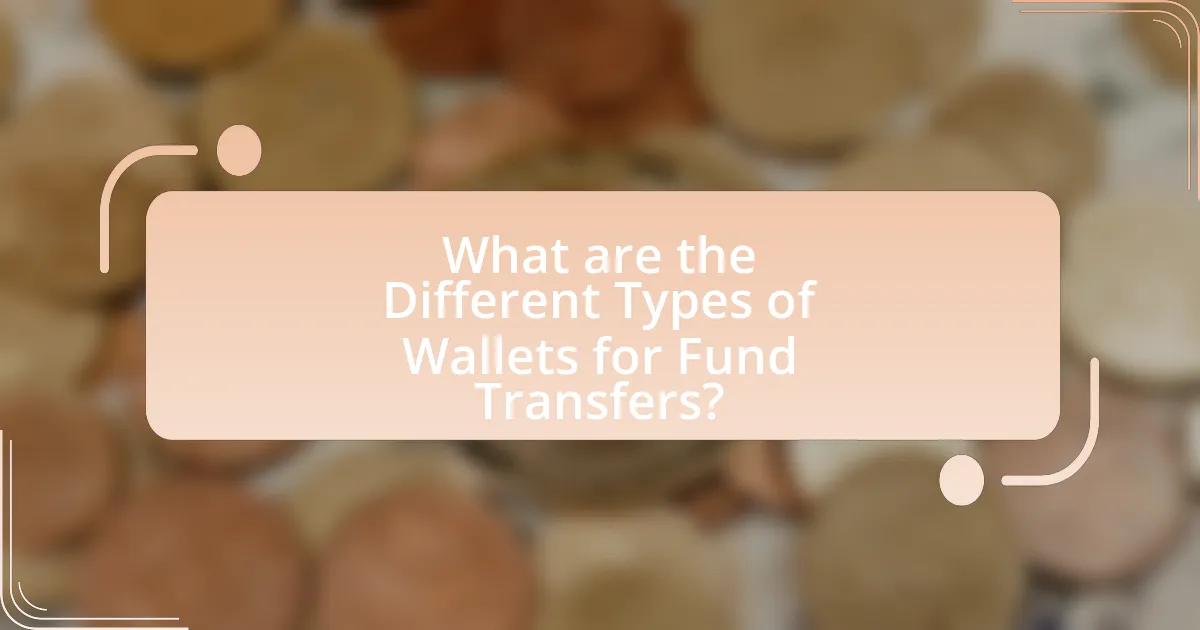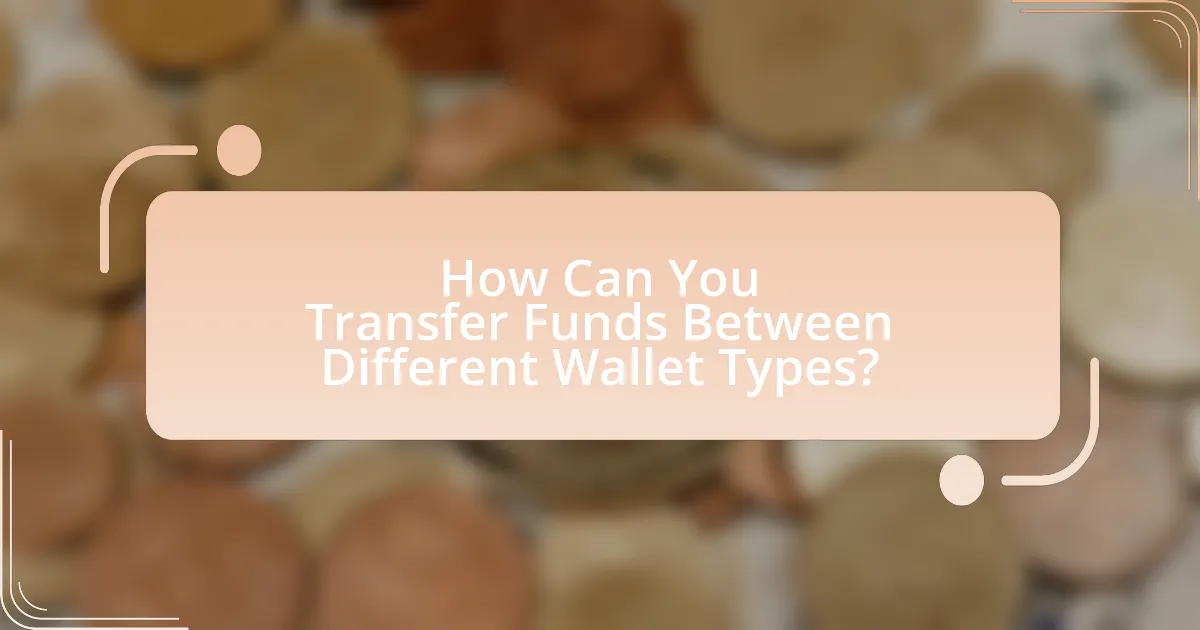The article focuses on the various types of wallets used for fund transfers, including digital wallets, mobile wallets, hardware wallets, and paper wallets. It outlines the differences between digital and traditional wallets, highlighting features, security measures, and categories of digital wallets. The article also details the process of transferring funds between different wallet types, including the necessary steps, common challenges, and best practices for secure transactions. Additionally, it addresses potential security risks and troubleshooting tips for failed transfers, providing a comprehensive guide for users navigating the complexities of fund transfers across various wallet types.

What are the Different Types of Wallets for Fund Transfers?
The different types of wallets for fund transfers include digital wallets, mobile wallets, hardware wallets, and paper wallets. Digital wallets, such as PayPal and Venmo, allow users to store and transfer funds electronically, often linked to bank accounts or credit cards. Mobile wallets, like Apple Pay and Google Pay, enable users to make transactions using their smartphones, providing convenience and security through encryption. Hardware wallets, such as Ledger and Trezor, offer a secure way to store cryptocurrencies offline, protecting against online threats. Paper wallets involve printing out private keys and public addresses, serving as a physical form of cryptocurrency storage. Each wallet type serves distinct purposes and offers varying levels of security and accessibility for fund transfers.
How do digital wallets differ from traditional wallets?
Digital wallets differ from traditional wallets primarily in their method of storing and managing money. Digital wallets store payment information electronically, allowing users to make transactions via smartphones or computers, while traditional wallets physically hold cash, cards, and coins. Digital wallets utilize encryption and security protocols to protect user data, whereas traditional wallets rely on physical security measures. According to a report by Statista, as of 2021, the global digital wallet market was valued at approximately $1.1 trillion, highlighting the growing preference for digital transactions over cash-based methods.
What features distinguish digital wallets from physical wallets?
Digital wallets are distinguished from physical wallets primarily by their electronic nature and functionality. Unlike physical wallets, which store cash and cards, digital wallets enable users to store payment information, loyalty cards, and even cryptocurrencies electronically on devices such as smartphones or computers. Digital wallets facilitate contactless payments and online transactions, providing convenience and speed that physical wallets cannot match. For instance, a study by Statista in 2021 indicated that mobile payment transactions were projected to reach $4.6 trillion globally, showcasing the growing reliance on digital wallets for financial transactions.
How do security measures vary between wallet types?
Security measures vary significantly between wallet types, including hardware wallets, software wallets, and paper wallets. Hardware wallets, such as Ledger and Trezor, provide high security by storing private keys offline, making them less susceptible to hacking. Software wallets, like mobile or desktop applications, offer convenience but are more vulnerable to malware and phishing attacks due to their online nature. Paper wallets, which involve printing private keys on paper, are secure from online threats but can be easily lost or damaged. According to a study by the Blockchain Research Institute, hardware wallets are considered the most secure option for long-term storage, while software wallets are recommended for frequent transactions due to their ease of use.
What are the main categories of digital wallets?
The main categories of digital wallets are mobile wallets, web wallets, and hardware wallets. Mobile wallets, such as Apple Pay and Google Pay, allow users to make transactions via smartphones. Web wallets, like PayPal and Venmo, enable online transactions through web browsers. Hardware wallets, such as Ledger and Trezor, provide secure offline storage for cryptocurrencies. Each category serves distinct purposes, catering to different user needs and security preferences.
What is a hot wallet and how does it function?
A hot wallet is a type of cryptocurrency wallet that is connected to the internet, allowing for quick and easy access to funds. It functions by storing private keys online, enabling users to send and receive cryptocurrencies instantly. Hot wallets are typically used for everyday transactions due to their convenience, but they are more vulnerable to hacking and theft compared to cold wallets, which are offline storage solutions. The ease of access provided by hot wallets makes them suitable for frequent trading and transactions, while their online nature necessitates robust security measures to protect against potential cyber threats.
What is a cold wallet and what are its advantages?
A cold wallet is a type of cryptocurrency wallet that is not connected to the internet, providing enhanced security for storing digital assets. The primary advantage of a cold wallet is its protection against online threats, such as hacking and malware, since it is offline and thus inaccessible to cybercriminals. Additionally, cold wallets often support a wide range of cryptocurrencies and allow users to maintain full control over their private keys, which is crucial for safeguarding assets. According to a report by the Blockchain Research Institute, cold storage solutions are considered one of the safest methods for long-term cryptocurrency storage, further validating their effectiveness in protecting digital assets.

How Can You Transfer Funds Between Different Wallet Types?
To transfer funds between different wallet types, you typically need to use a compatible exchange platform or service that supports both wallet types. For example, if you want to transfer funds from a cryptocurrency wallet to a fiat wallet, you can use a cryptocurrency exchange like Coinbase or Binance, which allows you to deposit cryptocurrency and withdraw fiat currency. This process involves creating an account on the exchange, depositing the funds from your original wallet, and then executing a withdrawal to your desired wallet type. The exchange facilitates the conversion and transfer, ensuring that the funds are moved securely and efficiently.
What steps are involved in transferring funds from one wallet type to another?
To transfer funds from one wallet type to another, follow these steps: first, identify the source wallet and the destination wallet. Next, access the source wallet and initiate a transfer by selecting the amount to send and entering the destination wallet address. Confirm the transaction details, including any fees, and authorize the transfer. Finally, check the destination wallet to ensure the funds have been received. This process is standard across various wallet types, including cryptocurrency wallets and digital payment platforms, ensuring compatibility and security in fund transfers.
How do you initiate a transfer from a digital wallet to a traditional wallet?
To initiate a transfer from a digital wallet to a traditional wallet, you typically need to withdraw funds from the digital wallet to a linked bank account and then withdraw cash from that bank account. This process involves accessing your digital wallet application, selecting the withdrawal option, entering the amount to transfer, and confirming the transaction. Once the funds are in your bank account, you can visit an ATM or bank branch to withdraw the cash and place it into your traditional wallet. This method is commonly used as most digital wallets do not directly support cash transfers to physical wallets.
What information is required to complete a wallet transfer?
To complete a wallet transfer, the required information includes the recipient’s wallet address, the amount to be transferred, and any necessary transaction fees. The recipient’s wallet address is a unique identifier that ensures the funds are sent to the correct destination. The amount specifies how much currency is being transferred, while transaction fees are often required to process the transfer on the blockchain or network being used. These elements are essential for the successful execution of a wallet transfer, as they ensure accuracy and compliance with the network’s protocols.
What are the common challenges faced during fund transfers?
Common challenges faced during fund transfers include transaction delays, high fees, and security concerns. Transaction delays often occur due to network congestion or processing times by financial institutions, which can lead to frustration for users expecting immediate transfers. High fees can arise from currency conversion, intermediary banks, or specific wallet services, making transfers costly. Security concerns are prevalent as users worry about fraud, hacking, and the safety of their financial information during the transfer process. According to a report by the World Bank, the average cost of sending remittances globally was 6.5% in 2020, highlighting the financial burden associated with fund transfers.
How can transaction fees impact the transfer process?
Transaction fees can significantly impact the transfer process by influencing the speed and cost-effectiveness of transactions. High transaction fees may deter users from completing transfers, especially in low-value transactions, as the fees can exceed the amount being sent. For example, during periods of network congestion, fees can spike, leading to delays in transaction confirmations as users may opt to wait for lower fees or abandon the transfer altogether. This behavior is supported by data from the Bitcoin network, where average transaction fees reached over $60 during peak times in 2021, causing many users to delay or cancel their transactions. Thus, transaction fees directly affect user behavior and the overall efficiency of fund transfers between different wallet types.
What security risks should you be aware of when transferring funds?
When transferring funds, you should be aware of several security risks, including phishing attacks, transaction fraud, and inadequate encryption. Phishing attacks involve deceptive communications that trick users into revealing sensitive information, leading to unauthorized access to funds. Transaction fraud occurs when malicious actors manipulate transactions to divert funds to their accounts, often exploiting vulnerabilities in the transfer process. Inadequate encryption can expose sensitive data during the transfer, making it susceptible to interception by cybercriminals. According to the Federal Trade Commission, consumers reported losses of over $1.9 billion to fraud in 2020, highlighting the importance of vigilance in securing fund transfers.

What Best Practices Should You Follow When Transferring Funds?
When transferring funds, best practices include verifying recipient details, using secure networks, and keeping transaction records. Verifying recipient details ensures that funds are sent to the correct account, reducing the risk of loss. Using secure networks, such as encrypted connections, protects sensitive information from potential cyber threats. Keeping transaction records provides a reference for future inquiries and helps in tracking any discrepancies. According to the Federal Trade Commission, these practices significantly reduce the likelihood of fraud and errors in financial transactions.
How can you ensure a secure transfer between wallet types?
To ensure a secure transfer between wallet types, utilize multi-signature wallets and verify addresses before initiating transactions. Multi-signature wallets require multiple private keys to authorize a transaction, significantly reducing the risk of unauthorized access. Additionally, verifying addresses helps prevent sending funds to incorrect or malicious addresses, which is crucial given that blockchain transactions are irreversible. According to a report by Chainalysis, over $2.8 billion was lost to scams and hacks in 2021, highlighting the importance of these security measures in safeguarding assets during transfers.
What precautions should you take before initiating a transfer?
Before initiating a transfer, verify the recipient’s wallet address to ensure accuracy. Mistakes in the wallet address can lead to irreversible loss of funds, as transactions on blockchain networks are permanent. Additionally, confirm the compatibility of the wallet types involved in the transfer, as some wallets may not support certain cryptocurrencies or tokens. It is also advisable to check the transaction fees and processing times associated with the transfer, as these can vary significantly between different wallets and networks. Lastly, consider conducting a small test transfer to confirm that the process works correctly before transferring larger amounts.
How can you verify the recipient’s wallet address effectively?
To verify the recipient’s wallet address effectively, you should cross-check the address with the recipient directly and use a blockchain explorer to confirm its validity. Direct communication ensures that the address is accurate and reduces the risk of errors. A blockchain explorer allows you to input the wallet address and view its transaction history, confirming that it is active and capable of receiving funds. This method is supported by the fact that blockchain technology provides transparent and immutable records of all transactions, making it a reliable source for verification.
What troubleshooting tips can help if a transfer fails?
If a transfer fails, first check the network status to ensure that the blockchain is not experiencing congestion or downtime. Network issues can cause delays or failures in transactions. Next, verify that the wallet addresses are correct, as incorrect addresses will lead to failed transfers. Additionally, ensure that there are sufficient funds in the sending wallet to cover both the transfer amount and any associated transaction fees, as insufficient funds will prevent the transfer from being processed. Lastly, review any error messages provided by the wallet or exchange, as they often contain specific information about the failure, allowing for targeted troubleshooting.
What steps should you take if a transaction is delayed?
If a transaction is delayed, first verify the transaction status through the wallet or platform used for the transfer. This can often be done by checking the transaction ID on the blockchain explorer or the transaction history in the wallet. If the transaction is still pending, wait for a reasonable period, as some transactions may take longer due to network congestion. If the delay exceeds typical processing times, contact customer support of the wallet or platform for assistance. Providing them with the transaction ID and details will help expedite the resolution process.
How can you recover funds if they are sent to the wrong wallet?
To recover funds sent to the wrong wallet, the first step is to contact the wallet provider or exchange where the funds were sent. Many wallet providers have procedures in place for handling such situations, and they may be able to assist in retrieving the funds if the transaction is reversible. For example, if the funds were sent to a centralized exchange, the user can provide transaction details to the support team, who may be able to reverse the transaction or return the funds if they are still within their control. However, if the funds were sent to a decentralized wallet, recovery is often not possible due to the irreversible nature of blockchain transactions. According to blockchain principles, once a transaction is confirmed, it cannot be undone, emphasizing the importance of double-checking wallet addresses before sending funds.